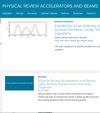欧洲核子研究中心大型强子对撞机实验插入非线性误差的首次测量与修正
Physical Review Special Topics-accelerators and Beams
Pub Date : 2015-12-07
DOI:10.1103/PHYSREVSTAB.18.121002
引用次数: 26
摘要
低β插入的非线性磁误差会导致振幅失谐、线性失谐和非线性失谐,并导致动态孔径和光束寿命的降低。因此,对撞机实验插入的非线性误差的校正对成功运行具有至关重要的意义。预计这将与大型强子对撞机的第二次运行及其高亮度升级,以及未来的对撞机(如未来的圆形对撞机)特别相关。目前为这些对撞机设想的修正策略假设,可以使用误差的磁模型,通过插入计算出优化的局部修正。然而,本文表明,仅依靠磁测量插入元件的非线性误差不足以保证在相关的低β区有良好的校正质量。在闭合轨道碰撞的应用下,通过反馈到容易观察到的光束特性,可以执行基于波束的非线性磁误差检测,并且基于反馈到调谐的方法已经在RHIC, SIS18和SPS上使用。本文证明了这种方法的扩展,以包括在大型强子对撞机中直接观察反馈到线性耦合。进一步表明,这种基于束流的研究可以用来补充在大型强子对撞机建设期间进行的磁测量,以验证和完善对撞机的磁模型。本文介绍了大型强子对撞机实验插入中非线性误差的首次测量和修正结果。本文报道了基于束流的研究与大型强子对撞机磁模型的几个差异。本文章由计算机程序翻译,如有差异,请以英文原文为准。
First measurement and correction of nonlinear errors in the experimental insertions of the CERN Large Hadron Collider
Nonlinear magnetic errors in low-β insertions can contribute significantly to detuning with amplitude, linear and nonlinear chromaticity, and lead to degradation of dynamic aperture and beam lifetime. As such, the correction of nonlinear errors in the experimental insertions of colliders can be of critical significance for successful operation. This is expected to be of particular relevance to the LHC’s second run and its high luminosity upgrade, as well as to future colliders such as the Future Circular Collider. Current correction strategies envisioned for these colliders assume it will be possible to calculate optimized local corrections through the insertions, using a magnetic model of the errors. This paper shows however, that reliance purely upon magnetic measurements of the nonlinear errors of insertion elements is insufficient to guarantee a good correction quality in the relevant low-β � regime. It is possible to perform beam-based examination of nonlinear magnetic errors via the feed-down to readily observed beam properties upon application of closed orbit bumps, and methods based upon feed-down to tune have been utilized at RHIC, SIS18, and SPS. This paper demonstrates the extension of such methodology to include direct observation of feed-down to linear coupling in the LHC. It is further shown that such beam-based studies can be used to complement magnetic measurements performed during LHC construction, in order to validate and refine the magnetic model of the collider. Results from first attempts of the measurement and correction of nonlinear errors in the LHC experimental insertions are presented. Several discrepancies of beam-based studies with respect to the LHC magnetic model are reported.
求助全文
通过发布文献求助,成功后即可免费获取论文全文。
去求助
来源期刊
自引率
0.00%
发文量
0
审稿时长
3-8 weeks
期刊介绍:
Physical Review Special Topics - Accelerators and Beams (PRST-AB), is a peer reviewed, purely electronic journal, distributed without charge to readers and funded by contributions from national laboratories. It covers the full range of accelerator science and technology: subsystem and component technologies, beam dynamics; accelerator applications; and design, operation, and improvement of accelerators used in science and industry. This includes accelerators for high-energy and nuclear physics, synchrotron radiation production, spallation neutron sources, medical therapy, and intense beam applications.

 求助内容:
求助内容: 应助结果提醒方式:
应助结果提醒方式:


